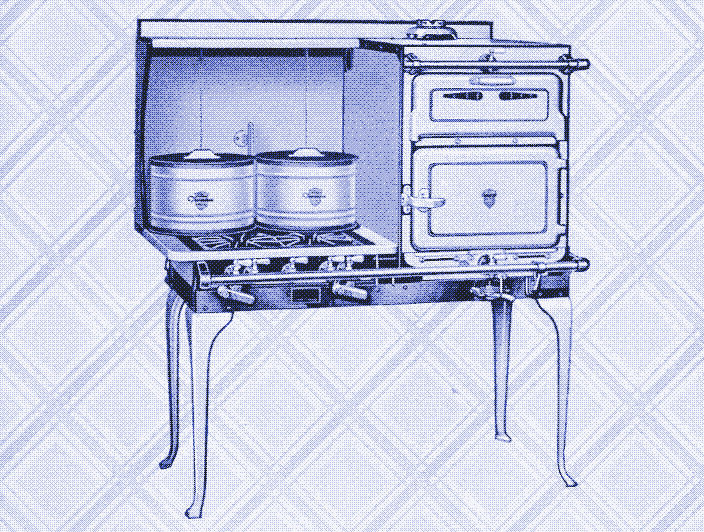
While modern cooking stoves are convenient, when it comes to energy use they leave a lot to be desired. As we have seen in the previous article, the thermal efficiency of an electric hob does not exceed that of a conventional open fire. In both cases almost 90% of the primary energy is lost during the cooking process.
Cooking food could be achieved in a far more energy efficient way, especially if the cooking pot itself is insulated. This is the principle behind the fireless cooker, a well-insulated box that keeps food simmering with only the heat of the cooking pot itself. A fireless cooker doubles the efficiency of any type of cooking device because it shortens the time on the fire and limits heat transfer losses.
In the early twentieth century, fireless cookers were common additions to western kitchens, similar to the refrigerator or cooking stove. Some models even integrated fireless cookers with gas or electric hobs. These functioned by lowering an insulated hood over the cooking pot once the heat had been switched off.
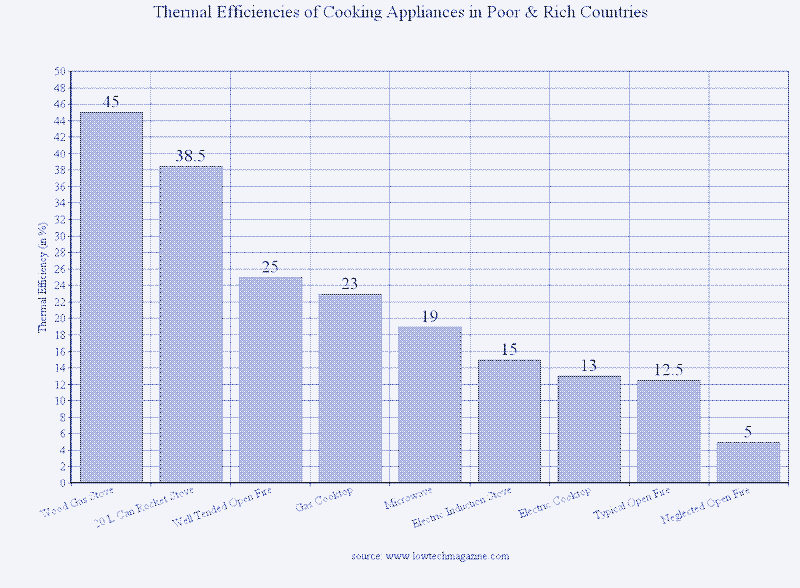
In the previous article, we found that cooking food is an incredibly inefficient process. The thermal efficiency varies from 13% for electric hobs to 23% for gas hobs, and from 5 to 25% for open fires and crude biomass stoves. Cooking stoves also produce considerable levels of indoor air pollution — especially in developing countries but also in the modern kitchens of wealthy households. These results show that in both developed and developing nations, energy efficiency and pollution levels in the cooking process can stand to be improved.
The proposed strategies to tackle these issues differ for poor and rich countries. In poorer countries, most efforts concentrate on improving energy efficiency and lowering the indoor pollution caused by biomass stoves. Rocket stoves, for example, can achieve thermal efficiencies of 45% or more, with only about half of the emissions. However, any type of improved biomass stove still requires wood for fuel, and continues to produce air pollution.
In the western world, the proposed solution is a more widespread use of the best available technology, such as electric induction stoves. However, these devices obtain a thermal efficiency of only 15%, which means that 85% of the energy generated for cooking is wasted. In summary, the present-day approach to improving the sustainability of cooking stoves is not very ambitious.
Why is cooking so inefficient?
To further improve upon the efficiency of cooking, we have to take a closer look at where the greatest energy losses are incurred. For electric hobs and microwaves, the most significant waste of energy can be attributed to power conversion losses. Converting fossil fuels or biomass into electricity produces an energy efficiency level of 20-45% depending on the power plant, which explains why electric stoves are among the least efficient cooking devices.
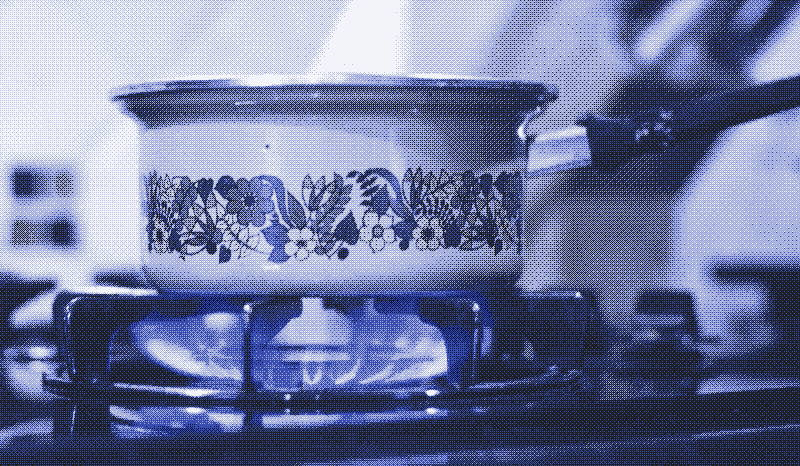
The second most significant energy loss for electric stoves, and the most important one for all other cooking stoves, occurs during the transferral of heat from the cooking hob to the food in the cooking vessel. Not all heat produced by the fire reaches the cooking pot, and heat is lost through the walls and lid of the pot, as well as through escaping steam.
The cooking process is similar to heating an uninsulated building with all the doors and windows open
In order to bring water to a boil and to keep a dish simmering, the cooking stove has to continuously compensate for these heat transfer losses. This is similar to heating an uninsulated building with all the doors and windows open. Even the most performable stoves now available — rocket stoves and wood gas stoves — only achieve a maximal thermal efficiency of 40-50%.
Obviously, we could do better. With regards to potential improvements in cooking sustainability, four technologies deserve further attention: pot skirts, fireless cookers, pressure cookers, and solar cookers. While each of these is a solution in themselves, they are especially advantageous when used together.
Pot Skirts
A simple way to start improving cooking efficiency is by using a pot skirt. This device increases heat transfer efficiency between cooking stove and cooking pot. They work with all but the electric stove. A pot skirt is a vertical sleeve, usually of metal, that forces the hot gases from the fire to flow closely around the sides of the pot. Skirts can be insulated on the outside, which brings the additional benefit of decreasing heat losses from the sides of the pot.
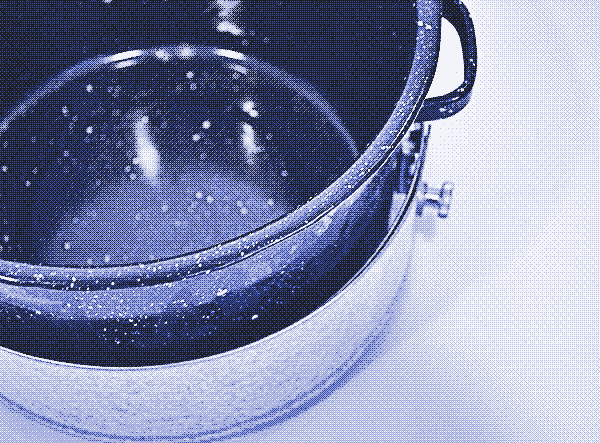
A pot skirt also reduces the effects of fire assymetry, which can be a problem for both outdoor and indoor cooking. Experiments in rooms with virtually no crossflow of air can show highly assymetric flame patterns, which decrease heat transfer efficiency. Tests on three types of stoves — an open fire, a biomass rocket stove and a gas rocket stove — showed that pot skirts can improve heat transfer efficiency by about 10-20% for a rocket stove, and by about 30% for an open fire. Since heat transfer losses are the main inefficiency for these types of cooking stoves, this is not a bad start.
Pressure Cookers
The rather well-known pressure cooker takes a different approach. A pressure cooker is a sealed vessel which reaches higher water temperatures because of added steam pressure, making it more energy efficient and able to cook food faster. It is either operated electrically (as a standalone device or on an electric stove), or used in combination with a gas, biomass, coal or solar stove. The pressure cooker lowers both power conversion losses (because of shorter cooking times) and heat transfer losses (because it completely eliminates heat loss through evaporation).
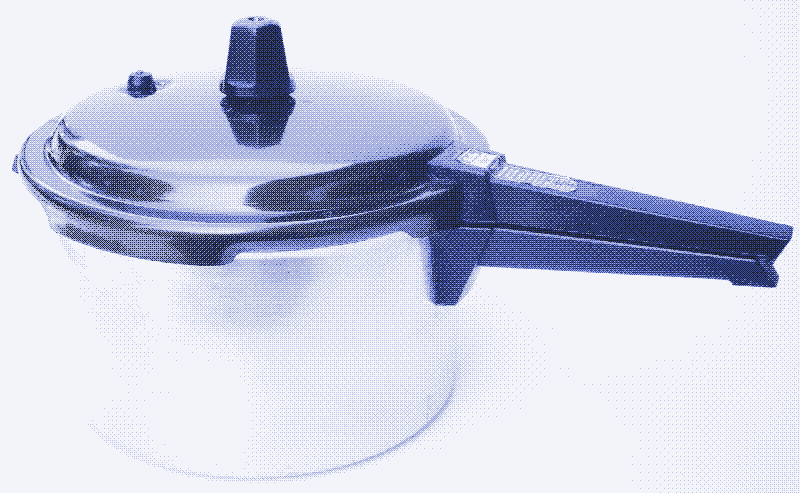
Scientific studies on the energy efficiency of a pressure cooker could not be found. Manufacturers usually advertise energy and time savings of up to 70% when compared to cooking in a normal pot. If we assume these figures to be correct averages (which is probably overly optimistic), then the thermal efficiencies of cooking stoves start to look more promising.
If a pressure cooker is used on an electric stove, the cooking process would reach a thermal efficiency of 22%, which brings it on par with a well-tended three-stone fire. The combination of a gas stove with a pressure cooker would achieve a thermal efficiency of 39%, while the combination of a well-tended three-stone fire with a pressure cooker would obtain 40% thermal efficiency. The best result is achieved via the combination of pressure cooker and rocket stove, which is 62% effective. 1
Fireless Cookers
While we can see marked improvements with the pressure cooker, these vessels still lose heat through the walls and lid, and these losses are considerable. There are also heat transfer losses between the stove and the pot if the device is placed on a hob. However, if we bring food to a boil and then quickly put the pot in a well-insulated box, the heat transfer energy losses can be minimized to such an extent that the cooking process continues, without any further energy input.
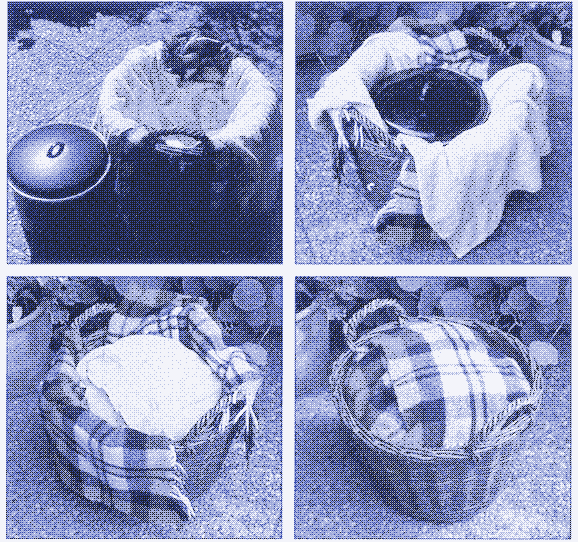
This is the principle of the “fireless cooker” or “heat retention cooker”, which is best described as the passive house concept applied to cooking. A passive house is a well-insulated building that requires little energy for space heating of cooling.
The fireless cooker is the passive house concept applied to cooking
The fireless cooker is the key to efficient cooking in poor and rich countries alike. It almost completely eliminates heat transfer loss and reduces cooking time on the fire or hob substantially, thus addressing the two largest energy losses in the cooking process. Fireless cookers can lower energy use by more than 80%, but the precise savings potential depends on many factors. Such factors include the insulation material, the design of the fireless cooker, the required cooking time of the dish, the food itself, and the swiftness with which the cooking pot is moved from the stove to the fireless cooker.
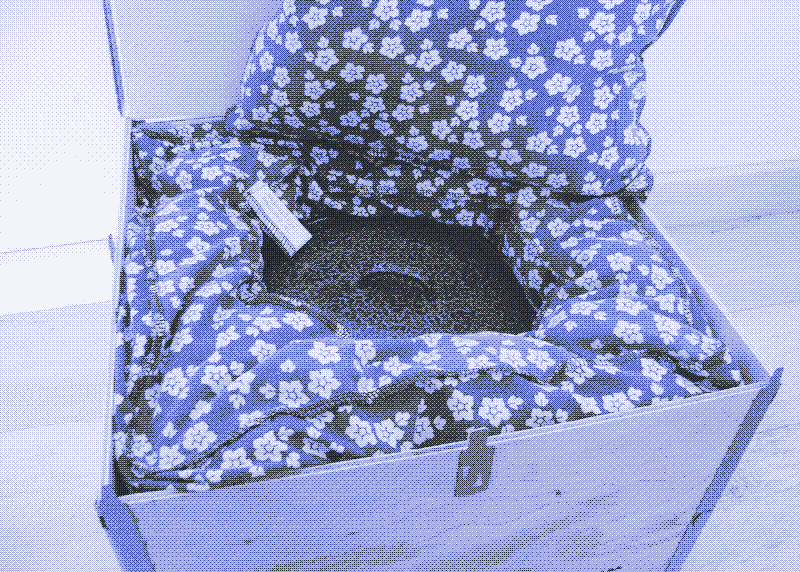
The Partnership for Clean Indoor Air (PCIA) has measured the energy savings of fireless cookers. In their test of 18 types of solid fuel cooking stoves, the energy savings of the fireless cooker amount to an average fuel reduction of 50%, which is the number we will use in this article.
If we combine an electric stove with a fireless cooker, we can double its thermal efficiency. Combined they reach 26%, which is still not very impressive, but at least achieves a higher energy efficiency than a gas stove alone. A gas stove used in conjunction with a fireless cooker obtains 46% thermal efficiency, while a well-tended fire with a fireless cooker attains 50%. A combination of a rocket stove with a fireless cooker is more than 80% efficient. 1
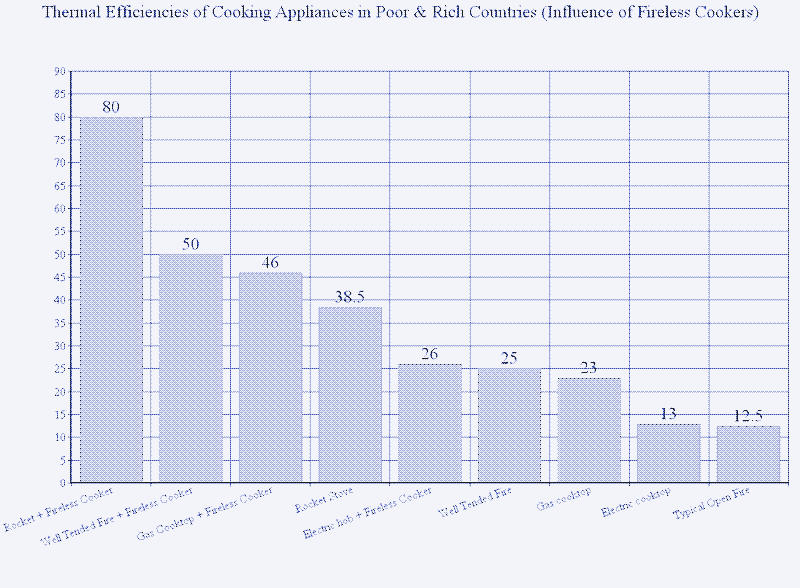
These numbers could be further improved if we combine the fireless cooker with the pressure cooker. If we use a pressure cooker to bring food to a boil and then put the pressure cooker into a fireless cooker, we can cook at 40%-90% efficiency, depending on the cooking stove used. This compares to a maximum of 23% for our western cooking stoves, and 40% — or at most 50% — for improved biomass stoves.
In its simplest form, the fireless cooker is a wooden, metal or plastic container filled with straw, old clothes, styrofoam, paper or any other insulation material. It can even be a cooking pot wrapped into a sleeping bag. Usually 5 to 10 cm of insulation is applied on all sides, the upper layer often in the form of an easy-to-handle, scaled-down mattress or pillow. A more cost-effective technique to lower energy use is hardly imaginable.
Fireless Cookers in History
In some parts of the world, the concept of the fireless cooker has been known about for centuries. During the middle ages, Europeans used “hayboxes” and holes in the ground filled with straw. American Indians took a slightly different approach to limiting heat transfer losses by enclosing the heat source (fire-heated stones or clay balls) within the cookware. Some American Indian groups used “cooking baskets” for this purpose; tightly woven watertight baskets, which could be coated with clay for insulation. Others stone-boiled soups and stews in a hole that they dug in the ground, lined with animal hide.
The fireless cooker became popular in the western world in the years between the 1890s and the 1930s. A Norwegian “self-cooking apparatus” received an award at the 1867 World Exhibition in Paris. It was a simple yet elegant container with four layers of felt for insulation.
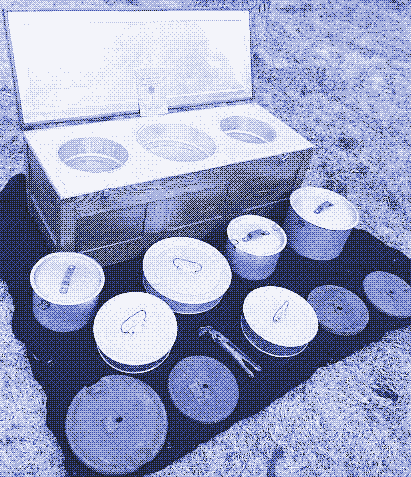
During the first decades of the twentieth century, the fireless cooker became a permanent fixture of many American and European households
Initially, the heat retention cooker was mainly used to make food more portable for use by people on the move such as fishermen, hunters and soldiers. Amsterdam trams (streetcars) had them onboard for the driver. However, during the first decades of the twentieth century, the fireless cooker also became a permanent fixture of many American and European households, an appliance often found next to the cooking stove.
The best models were made entirely out of metal lined with mineral wool insulation, and kept the cooking pot and insulating material separated for easy cleaning and durable construction. These devices were also used for cooling.
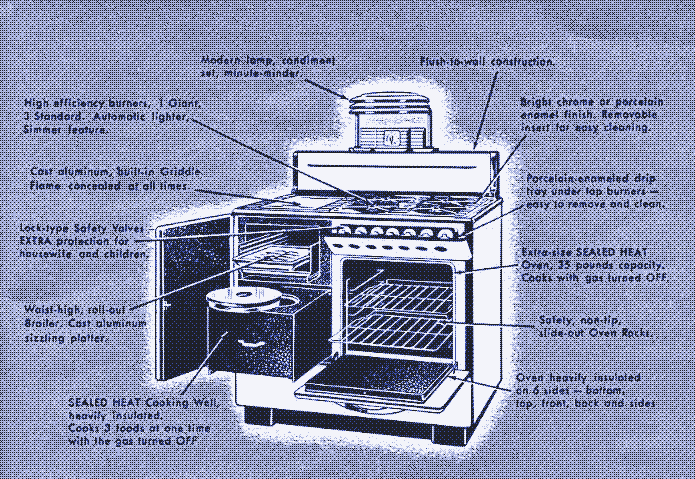
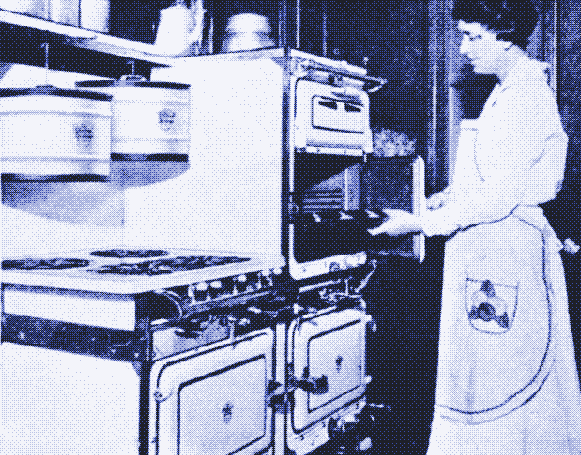
Another innovation from the early twentieth century was the fireless cooking gas range; a combination of gas stove, gas oven and fireless cooker. The device obviated the need to move cooking utensils from the hob to the fireless cooker by making use of insulated hoods — “thermodomes” — that could be lowered over the burners. The food was brought to a boil, the gas was shut off, and then the pot would be covered up by the thermodome. The inverted receptacle was raised and lowered with the assistance of a counterbalance.
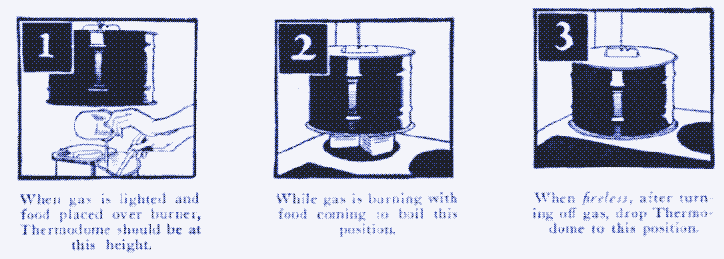
Interestingly, the hood was partially lowered while the gas was burning. The interior thus became hot from the heat which would otherwise escape, ensuring that plenty of retained heat would be available for cooking after the gas was turned off. Later versions worked completely automatically, shutting off the gas and lowering the hood at a preset time.
Another attempt to merge fireless cookers with cookstoves was the deep well cooker (also known as the “thrift cooker”). Old ranges, both gas and electric, sometimes had one of their burners sunk into a hole in the cooktop. This “well” had heavily insulated sides and enclosed a specifically designed pot with an insulated lid and no handles on the sides.
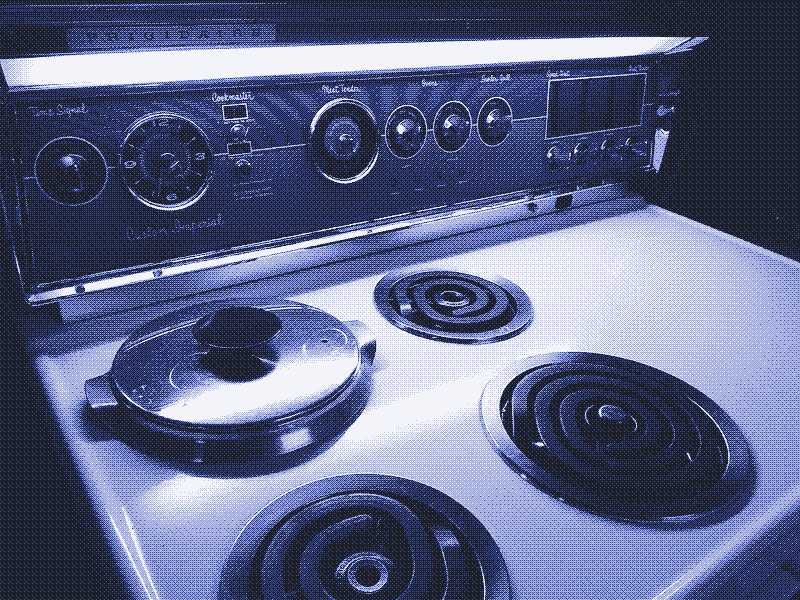
With some models, the burners could double as a surface unit. Although they were not really fireless cookers — the pot was on a low fire — deep well cookers reduced heat transfer losses considerably.
Improved Fireless Cookers
The use of heat retention cookers declined in the 1930s, and then resurfaced during World War Two and the oil crises of the 1970s. Today the fireless cooker is mainly promoted for use in developing countries. NGO’s that have introduced the technology are — among others — Practical Action, HELPS International and Solar Cookers International. The designs made for developing countries differ, from the insulated baskets of Solar Cookers International to the styrofoam insulated Wonderbag or ONIL.
Although heat retention cookers can be made cheaply with natural and locally available resources, they could just as well be mass-produced using more sophisticated materials. While it makes the devices less sustainable in production, plastic has made fireless cookers more practical, and superior insulation materials have improved their performance.
The thermal cooker is a compact, high-tech version of a fireless cooker
An important innovation in the western market is the so-called thermal cooker which appeared in the 1990s. The device is based on vacuum technology: the principle behind the thermos flask. The thermal cooker is comprised of a removable cooking pot, with handle and lid, that fits inside a vacuum flask which has a diameter ranging from 20 to 50 cm. The cooking pot is heated on the cooking stove (regardless of type) and then moved to and sealed in the flask. Find an exampe here.
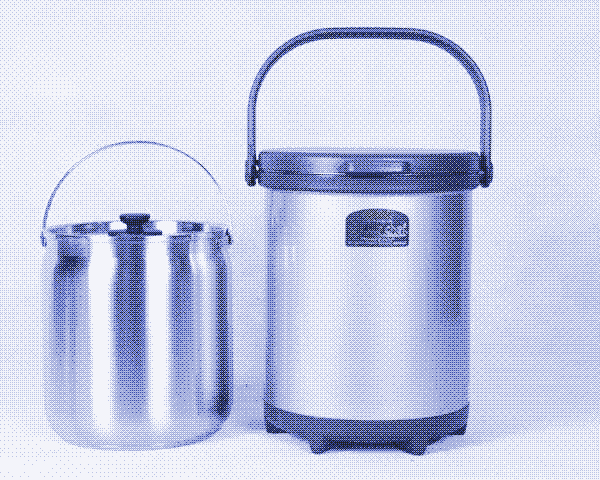
In a thermos flask or thermal vacuum cooker the space between the dual walls of a cylinder is completely evacuated. With virtually no molecules of gas available, heat transfer by conduction and convection are almost eliminated and therefore thermal conductivities are extremely low. Insulation thickness is about one-seventh of that of rockwool and one-third that of petrochemical insulation foams for similar thermal resistance.
The result is a much more compact fireless cooker, which could easily become part of any western kitchen as a standard, built-in device next to the cookstove. Smaller thermal cookers could be used to make hot food portable. Vacuum insulation is also available in the form of insulation panels, which you could use to build a compact yet superinsulated fireless cooker yourself. (But although home production is possible, one would have to adapt to available sizes — it’s not possible to cut the panels as this would destroy the vacuum).
All too often, fireless cookers are pictured as an emergency device aimed at campers, refugees or survivalists. However, a relatively simple device that can double the efficiency of whatever cooking technology you have at your diposal deserves more credence than that. The fireless cooker should be a commonplace item in every kitchen. Aside from its energy saving potential, its use in the western world would also encourage its acceptance in the developing world.
Time Saving
In the beginning of the twentieth century, time savings were the main sales argument for fireless cookers. This seems odd, because the average cooking time doubles compared to the traditional cooking process. Fireless cookers do afford the cook more time, however, by reducing the amount he or she spends in front of the stove or fire.
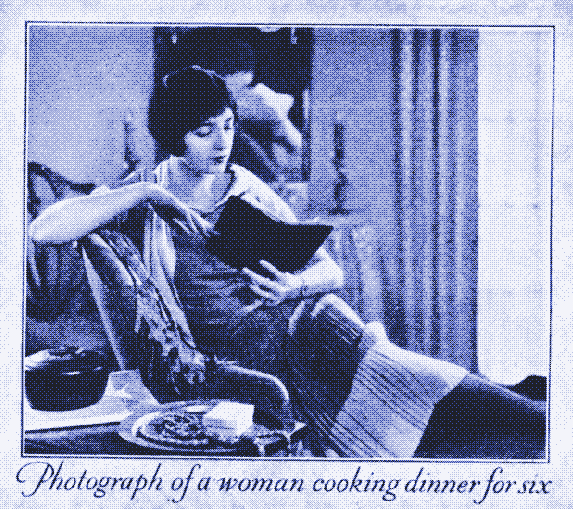
Once the cooking pot has been transferred to the fireless cooker, it requires no further attention and the cook is free to do something else, even if it’s outside the house. It’s impossible for the food to boil over, and there is no fire hazard to keep an eye on. Furthermore, a dish can stay hot for up to 6 hours or more, so the timing of the cooking process becomes more flexible.
A fireless cooker also increases the capacity of a cooking stove, whether it runs on electricity, gas, coal, wood or solar energy. You can put a new dish on the fire while the other one is simmering in the fireless cooker. With every fireless cooker you add, the capacity of the cooking stove increases further.
Solar Cookers + Fireless Cookers
This feature is especially interesting in combination with a solar cooker. A fireless cooker increases the capacity of a solar cooker, but it also allows you to cook if there is not much sun available. When a fireless cooker is used to complete the cooking process, a solar cooker requires as little as half an hour of sunshine to cook dinner.
Fireless cookers essentially act as batteries, storing energy in hot food. They greatly increase the usefulness of solar cookers, making them appropriate even on cloudy days and in countries where there is less sunshine. Furthermore, the combination of solar cooker and fireless cooker allows you to prepare a meal that can be served hours after sunset.
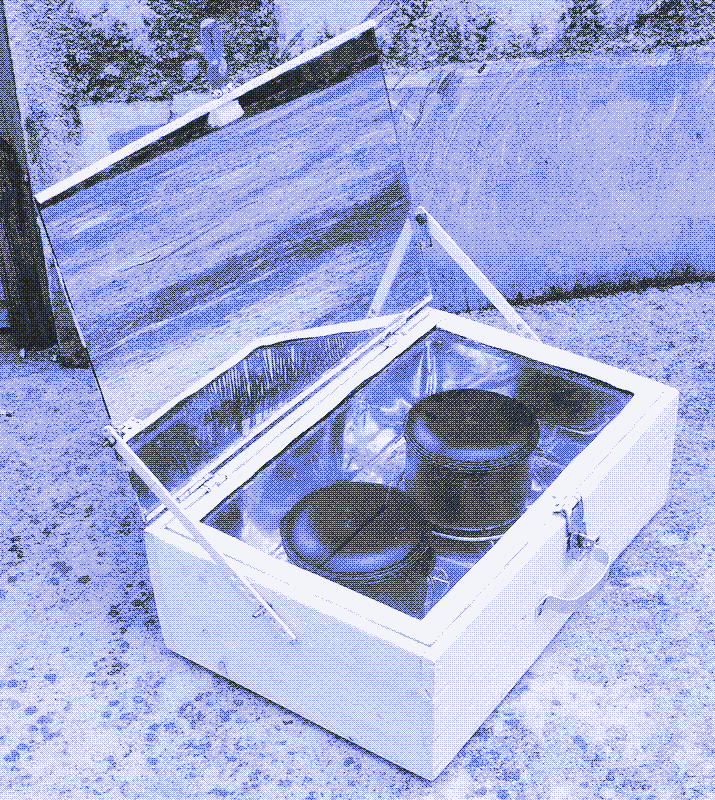
When viewed alongside all other cooking appliances, the solar cooker is the ultimately sustainable stove. It requires zero fuel and produces zero air pollution. Even if gas or solid fuel stoves could reach a thermal efficiency of 100%, they would still require resources like wood or coal, and they would continue to produce air pollution. The solar cooker is the only cooking device that doesn’t face these issues.
The fireless cooker greatly increases the usefulness of a solar cooker
There exist many designs for solar cookers. The simplest type is the solar box cooker, which is not much more than an insulated box with a glass plate on top. The glass allows solar radiation to enter, heating up the interior, while the insulated walls decrease heat loss. There is not much difference between a solar box cooker and a fireless cooker, and both appliances could be merged into one design. Solar box cookers can also work under cloudy conditions because they are able to exploit diffuse radiation.
Parabolic solar cookers incorporate a more complex design, and use curved mirrors to focus solar radiation on a focal point. They work faster, produce higher temperatures, and have the ability to fry, roast and barbeque food. They are, however, more challenging to build, they require frequent orientation to the sun, they can be dangerous, and they only work in clear weather conditions. Panel cookers — such as the CooKit — incorporate elements of both box and parabolic cookers.
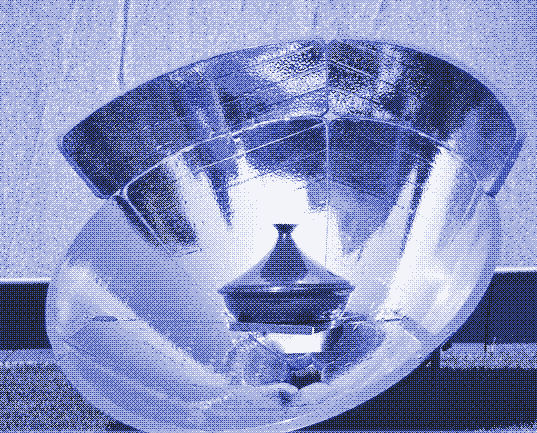
The solar cooker is not the only way to take advantage of solar energy for cooking. Electric cookstoves or microwaves run by electricity from PV solar panels can also be considered solar powered cookstoves. However, converting solar energy into electricity to convert it to heat in order to boil water is needlessly complex, energy inefficient, and very expensive compared to taking advantage of solar heat in a direct way by using a solar cooker.
Indoor Solar Cooking
Like improved biomass stoves and fireless cookers, solar cookers are mainly promoted in developing countries as an alternative to the use of open fires. The technology is distributed by some 500 organisations, companies, and individuals, united in the Solar Cookers World Network. The promotion of panel and box cookers is mostly aimed at households and refugees, while the more sophisticated parabolic cookers are generally reserved for large-scale cooking in institutions.
The promotion of solar cookers in developing countries has produced improved technology that can be useful all over the world. For example, it is now possible to cook indoors using solar energy. This can happen in two ways: either by focusing a parabolic cooker through a wall aperture and then reflecting the sunlight onto a cooking pot, or by using concentrated sunlight to generate steam which is then transported through pipes to a nearby indoor kitchen.
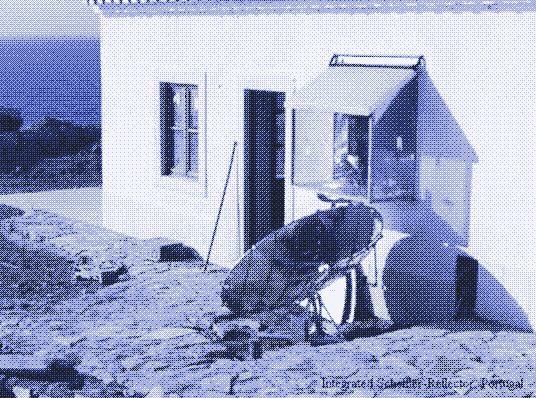
Both approaches were demonstrated in the Scheffler Community Kitchens in India. These cooking installations are applied on a very large scale, for example at the Shirdi Temple where a solar cooked lunch is served to over 50,000 people per day. However, using solar energy indoors can also happen on a much smaller scale, as is demonstrated by the system pictured above.
Solar cookers used in developing countries are usually not the most efficient devices. Improving them with more sophisticated materials greatly increases their usability
Although a remarkable and highly sustainable piece of equipment, most solar cookers used in developing countries are not the most efficient. As Appropedia notes, solar cookers are “solar concentrators where precision and efficiency have been sacrificed for ease of construction and use of readily available materials”.
The performance of these cookers could be enhanced if we built them in a more sophisticated way. For example, low-E window glass makes a solar box cooker much more efficient, as most heat that escapes from the box is through the glass. Solar Cookers International notes that the ongoing development of more efficient models continues to push the practicality of solar cookers into higher latitudes.
Making Cooking Sustainable: “Integrated Cooking”
Combining cooking stoves with solar cookers, fireless cookers, and pressure cookers turns an inefficient process into a year-round sustainable system that dramatically cuts greenhouse gas emissions, fuel use, and air pollution. This holds true for poor and rich countries alike, regardless of which type of cooking stove is used.
Increasingly, NGO’s are betting on a combination of solar cookers, fireless cookers and improved biomass stoves, an approach that is known as “integrated cooking”. [2] In “integrated cooking”, solar cookers are used whenever possible, while the improved biomass stove offers a solution when solar energy is not available. The fireless cooker is used in combination with both, increasing the capacity of the cooking system and maximizing energy efficiency. For an example, see this video.
A similar system in the western world could even utilise electric or gas stoves instead of improved biomass stoves. Because the use of fireless cookers, pressure cookers and solar cookers shortens the use of electric or gas stoves considerably, their low efficiency becomes less of a concern. If the energy use of gas and electric stoves is substantially reduced, it also becomes more realistic to supply this smaller amount of energy by renewable sources, such as wind power.
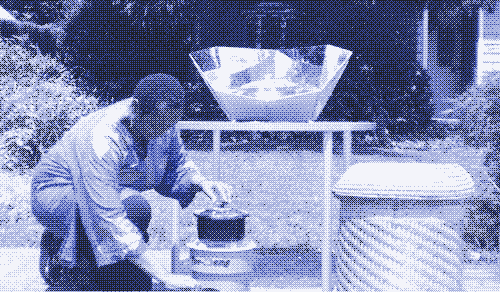
Increasingly, NGO’s are betting on a combination of solar cookers, fireless cookers and improved biomass stoves
Solar cookers and fireless cookers are good examples of the kind of technology that we aim for here at Low-tech Magazine. They can be cheap and easy to make, they are truly sustainable, and yet they are superior to any cooking technology available in pre-industrial times. The extensive use of water power and wind power in history seems to suggest that solar cooking goes back many centuries, but that is not the case. The first experimental solar box cookers only appeared in the 18th century, and parabolic cookers only showed up in the late 19th century.
Solar cookers and fireless cookers might have a very low-tech image, but they integrate well with high-tech materials. Before the Industrial Revolution, we had no tin or aluminium foil, no vacuum technology, no plastic containers, and no thermally insulated glass. Cooking with fireless cookers, pressure cookers and solar cookers is not a return to the now impractical or defunct gadgets of the past. Rather, it is an innovative approach that optimizes existing knowledge and technology with the aim of radical energy efficiency.
Thanks to all readers who have urged me to write about fireless cookers.
Reactions
To make a comment, please send an e-mail to solar (at) lowtechmagazine (dot) com. Your e-mail address is not used for other purposes, and will be deleted after the comment is published. If you don’t want your real name to be published, sign the e-mail with the name you want to appear.
Reactions
Jon Freise
Fantastic article! I just discovered fireless cooking using an old Stanley Thermos to cook oat groats for breakfast. It cooks overnight, always works perfectly, never boils over, and even works in a hotel room with an electric kettle. We hardly cook oatmeal any other way.
You bring up Low-E glass coatings for solar box ovens. I wonder if the vacuum insulated glass might be an ideal application. The glass has visual distortions, but that would not be an issue with solar cookers.
j
Sounds a bit like the cooler sous vide cooking technique. Put some food in a ziploc, put some hot water in a cooler, place ziploc in, and wait.
http://www.seriouseats.com/2010/04/cook-your-meat-in-a-beer-cooler-the-worlds-best-sous-vide-hack.html
works very well. Alas, it can be wasteful of water, but you can always re-use it for drinking, cleaning, etc.
Poul-Henning Kamp
Electrical induction deserves a closer look.
Since there are no particular hot parts near the pot, you can in principle wrap your pot in textile insulation while you cook without fire-risk.
Spills will still be a mess though, but we can do better:
Induction pots could have a a radiation shield (“Calorimeter principle”) insulation: The exterior wall made from non-magnetic metal, such as aluminum or brass, the interior pot from iron.
Done right, such an “insulated induction pot” would not appear different from most common cooking pots today, and can even be put into dishwashers etc.
Claire Leavey
Lovely article. I’ve written about these (and fuel efficiency in general) in ‘How to run a Thrifty Kitchen’! http://www.retrometro.co/shop/how-to-run-a-thrifty-kitchen.html
Lloyd Alter
The toledo cooker was very popular a hundred years ago in America, and there are still versions being made http://www.treehugger.com/kitchen-design/nissan-thermal-cooker-crockpot-without-cord.html
pond
What about slow cookers or crock pots? Similar to the fireless cooking, but electrical. Not insulated, but if you have a slow cooker, you could build a hot box in which to put it. Once you know how long the crock pot takes to bring the contents up to a boil, you could plug it into a timer.
The crock pot cord goes through a hole punched in the bottom of the hot box, plugs into a timer. The timer turns off the crock pot after 2 hours (or however long it takes for the pot to get up to a boil).
Peder
Like this article series! Well done!
Also liking Poul-Henning Kamps comment. Sounds interesting.
A field for further studies is obviously camp stoves where fuel efficiency is a big factor, and the designs reflect that fact.
Insulation for a camping cook pot is commonly called a “pot cozy” and varies from retail neoprene versions to homemade bubble wrap contraptions. Could be something for home use as well.
The pot skirt concept is well utilized in the Trangia type of stoves, where the windshield of the stove goes a way up the sides of the pot. There are others as well.
kris de decker
@ Greg & Mario
What you cook indeed matters. It should also be noted that water is a more efficient heat transfer medium than oil, while oil is a more efficient heat transfer medium than air. Therefore, boiling food is always more efficient than frying or baking it.
In fact, when it comes to carbon emissions, the diet is more important than the cooking technology. For instance, boiling meat is more carbon intensive than frying vegetables, because meat production is inefficient.
@ Tim & David
Cooking pot design is important, too. Material, shape, color. I’ve seen a similar finned pot for use in a solar box cooker.
Myrtonos
Like improved biomass stoves and fireless cookers, solar cookers are mainly promoted in developing countries as an alternative to the use of open fires.
Note that developing coutries have on average more sunshine than developed ones. They are generally closer to the equator.
One thing the article doesn’t mention is why insulated cookers fell from favour.
David Wilson
If I understand the fireless cooker, the traditional Hawaiian imu would qualify as an industrial-strength fireless cooker. A wood fire heats rocks, which are then placed in and around the food in a covered pit. My wife’s family cooks this way for luaus on the Big Island. I don’t know how efficient it is, but the results taste fabulous.
Wikipedia has a good description in an article on kalua cooking: http://en.wikipedia.org/wiki/Kalua
Tim Barker
Hi Chris great article. It was good to see someone make the link between pressure cookers and retained heat cooking , we have used such a system in the past with very good results. Pressure cookers and solar also are a good combination but older pressure cookers with a bobble weight are better as the new ones require quite a head of stem to initially seal. At the Koanga institute where i do some work on Appropriate technology we did some tests with retained heat cookers where we installed the heating element out of an old slow cooker (approx 170 watts) and added a thermostat out of a hot water system which matches the heat range required well. Quite literally our hot box was an old solar oven with an insulated lid substituted for the glass and the heating element was sandwiched to the bottom of the bottom tray with a strip of aluminium. Our testing showed a minimum of 70% reduction in electricity used. Such a system if well built brings up some interesting possabilities as it could be used as a hot box, solar oven, or slow cooker and would cope very well in difficult climates. Worth mentioning also is the cooking pots themselves. Wide bases and good conductivity (tinned copper pots) over smaller footprint heating sources are the go.
Cheers Tim
Mark McClure
One more energy-saving cooking device is the “cooking pin.” It is basically a sealed tube, partially filled with liquid. The chef would insert the pin half way into a roast and then cook in the oven. The pin would transfer heat to the center of the roast for quicker cooking.
And I remember my mother had thick aluminum nails, which she would insert 1/2 way into potatoes to make them bake faster. (Pre-microwave days.)
greg blonder
An excellent review, and a reminder that the biggest deposit of fossil fuels in the world are energy efficiency improvements under our control.
Sadly, when I was in high school in the 70s I wrote a similar paper in response to the OPEC energy crisis. Even had a chance to cook on a deep-well stove. With the enthusiasm of a teenager, boldly predicted all new stoves would consume 1/3rd the energy in 15 years. Ah well.
Note an electric crock pot with decent insulation and a feedback controller is quite efficient, and bridges the gap between fireless insulated pots and the oven. But most are pieces of junk. Conversion efficiencies do put electricity at a disadvantage, but co-gen and community power can bring it back in line.
Also, WHAT you cook matters, and it is hard to shift cultural tastes. Steaming veggies can take 1/3rd the energy of boiling, if you only steam the minimum amount of water required. But people often grow up the taste and texture of boiled.
David Karger
Here’s another innovation: fins on the pot to collect extra heat from the flame: http://www.latimes.com/food/dailydish/la-dd-saucepan-rocket-scientist-heat-efficient-20140710-story.html
Mario Stoltz
Hello Kris,
your article made a concrete difference in my camping vacation in Sweden this summer. I used a Trangia cooker (works on alcohol). Already in a past year, I built myself a windscreen in 6 segments from 1mm aluminium plate and hinge ribbons. So far, I have only used this by forming a U-shaped windscreen around the cooker with the opening facing away from the wind.
This year, I have closed the screen around the cooker (a fairly snug fit, though just by accident) and tried to put a partial lid on top if I had any suitable objects at hand. The difference in cooking time was immediately obvious. I have no measurement but would estimate at least 20% shorter time to get water to boiling point, even with such a rudimentary insulation. Thanks a lot!!
Etienne Bayenet
Hello,
I also wrote an article (in French) about saving energy while cooking. The concept in the article is that reducing waste does not reduce our comfort, so I wanted to explain where energy is wasted. I didn’t know about the fireless cooker when I wrote it.
You will find it with another about drying clothes on this page.
http://bayenet.jimdo.com/energie-et-m%C3%A9nage/
Since I found this article about insulated cooking pot great, I also added a link to it.
Best regards,
Etienne Bayenet
Pete Sherwood
@Kris
Have you found any references to using (or not) cast iron in/with fireless cooking?
Although getting the cast iron up to temperature takes longer, it seems to be the perfect match for the retention of heat in the fireless box.
I’ve seen no mention of this in the several articles I’ve read.
RKL
I’m rather surprised nobody has made mention of Rice Cooker appliances yet. Any halfway decent one will be insulated. You can touch the outside of it and it will be cooler than the surface of a car on a hot summer day, while rice is boiling inside. They are popular in Asian countries where energy is more expensive (phils for instance). They are also very cheap (I think I paid $20 for mine). Very handy appliance!
JohnMc
As one commenter just mentioned, the ole stanley thermos is my standard in fireless cookery. Metal model only please. Great for anything that will fit the small mouth opening. Done soups, stews, rice, etc this way.
Robert
To slow cook beans, lentils etc., I bring a pressure cooker to the boil, take it off the heat and wrap it in an old down jacket for a few hours. Works a treat.
Martin Zvieger
Great article
Three years ago I arrived at the idea to search for vaccum insulated cookware. Strange that the idea of the vaccum flask has never been applied to pots.
Swiss company Kuhn-Rikon offers a product line of doubled walled pots called Durotherm. http://www.kuhnrikonshop.com/category/energy-efficient-cookware-durotherm
It’s a convenient alternative to fireless cooking as you start saving energy in the heating phase.
From questions posted on the Internet I jump to the conclusion that there is demand for highly optimized cookware, what’s missing is an industry jumping up the bandwagon.
Take cheap rice cookers - which are operated in the zillions. What a waste - we can build them near thermodynamic optimum and make them last for generations.
Jeff
I agree transferring a heated pot to cold insulation is not ideal.
It would be so much better if pot and heating element were well insulated.
I have long wanted to try a base heating element and pot sides, both completely enclosed in vacuum insulation.
Slowburn
I wrapped a large stock pot with an old towel to use on an under sized electric burner for boiling several gallons of water at once. It brought the water to a boil in notably less time and would maintain the boiling when I took the lid off. Encouraged I then spread another towel over the top and it again boiled much sooner and much more energetically. I am looking for expanding foam suitable for sealing around fireplaces for a permanent fix.
GB
I have an antique (80 year old) Faultless Fireless Cooker made by the Diller Manufacturing Co. which is complete and still cooks very well.
But it is not as efficient as my 6 liter Thermos Shuttle Chef that has two 3 liter cooking pots and one 6 liter cooking pot. We use the Shuttle Chef at least once a week and find it indispensable in our kitchen.
A previous comment mentions the problems with small amounts of food not having enough thermal mass to cook food adequately which I would like to address:
One solution is to plan a meal that has rice in addition to the main course. For example I cook chicken tikki masala in one 3 liter pot and basmati rice in the other 3 liter pot.
Another solution is to cook spaghetti sauce in one 3 liter pot and fill the other 3 liter pot with boiling water. When the sauce is cooked I put the water pot back on the stove to cook the pasta - it typically takes less than 2 minutes to bring the water back to boiling!
Another solution is to use the pot of hot water to wash the dishes afterwards.
The 6 liter cooking pot I find is best suited and ideal for cooking large batches of chili, soups, stews, etc.
If you are interested there as some very informative videos for the Shuttle Chef on YouTube. Search “MrDsKitchen” or Shuttle Chef. I should also mention that the Thermos Shuttle Chef is great for camping and boating.
I am not affiliated with Thermos. Just a very happy user.
GB
Elmo Dutra Filho
Congrats Kris!!! Excelent article! Wonderful graphics, images. I was looking for that!
I’ve been using heat retention for years, and decided to write about it! I use solar and pressure cooker, plus heat retention box I did six years ago! Still working! White rice I can prepare with only one minute in pressure cooker (steam) plus 35 minutes in heat retention box. Beans I can prepare in two times, only 2 (two) minutes of pressure (steam) plus two periods of 35 minutes. I said two minutes of steam!
I’m from Brazil, webmaster of site www.fogaosolar.net , mechanical engineer and professor. In my country, unfortunatly, we don’t use heat retention! I would like to show this advantages to poor comunitys in my country. Thanks for this oportunity. Excuse for my bad english!
Stewart MacLachlan
This is probably one of the very best articles in a crowded field at low tech magazine. I keep returning for a read. It could do with being reposted at the top of the list.
As an enthusiast of solar and integrated cooking, which I promote here in the UK on a shoestring, it touches on these subjects brilliantly, cooking efficiency is low hanging fruit for energy efficiency. developments in solar cooking are moving fast, but it’s mostly unknown and unconsidered, compared to big ticket items like solar PV, or even solar garden lights - instant landfill!
My website is www.slicksolarstove.com if anybody is interested in how we’ve been getting on.
And also www.ecozoom-uk.com for rocket stoves, just need something for heat retention and I’ve got the set,
Thanks to Kris for the great site !
bss
there are also great looking
http://solgaz.eu/en/ceramic-gas-hobs/
Flameless gas hobs
Beautiful ceramic appearance, modern design, saving up to 50% on energy bills for gas and safety at a high level. Meet our invention and let yourself be inspire.
Connor
This is an interesting example of a solar cooker that uses vacuum insulated glass and a parabolic reflector: http://www.gosunstove.com/
anon
In the past 30 years, I have NEVER read an article that measures the inefficiency of a human scavanging wood or dung and carrying it to a fire.
The time value of that work, the calories expended, the human drudgery, seem to me to be on a par with the net efficiency of an electric power grid.
Adriana Botello
Hebbel cellular concrete is an outstanding insulator, and easy to work with.
Ann Ellis
You didn’t mention the efficiency of what you are cooking, such as meat vs vegetables.
Also no mention of the raw diet. Doesn’t this save fuel?
priscilla miller
this has been interesting and helpful. i was remembering stories of how folks long ago would use a fireless cooker for hot food after a long day at the county fair, or traveling in a wagon all day, harvest time or just a church gathering or picnic. it would be a wooden box, thick insulation such as straw and quilts and a strong guy to lift it all in the wagon or trunk of the car. after cooking all day, the family would have a hot meal that no one had to stand over and cook or get more fuel or get burned. sounds good to me!
thanks
Levitan Gallarde
https://m.youtube.com/watch?v=o65aNFurAGo&sns=fb
Matt
The link to the “An Investigation of Skirts” paper is outdated. Old link in the text:
http://www.vrac.iastate.edu/ethos/files/ethos2010/Saturday/Stoves,%20Electricity,%20and%20Heat%20Transfer/Skirts%20Paper_Andreatta.pdf
I found new links only on archive.org:
https://web.archive.org/web/20140719112746/http://www.vrac.iastate.edu/ethos/files/ethos2010/Saturday/Stoves,%20Electricity,%20and%20Heat%20Transfer/Skirts%20Paper_Andreatta.pdf">http://www.vrac.iastate.edu/ethos/files/ethos2010/Saturday/Stoves,%20Electricity,%20and%20Heat%20Transfer/Skirts%20Paper_Andreatta.pdf">https://web.archive.org/web/20140719112746/http://www.vrac.iastate.edu/ethos/files/ethos2010/Saturday/Stoves,%20Electricity,%20and%20Heat%20Transfer/Skirts%20Paper_Andreatta.pdf
https://web.archive.org/web/20120516003944/http://www.bioenergylists.org/files/ETHOS%202010%20Skirt%20paper.pdf">http://www.bioenergylists.org/files/ETHOS%202010%20Skirt%20paper.pdf">https://web.archive.org/web/20120516003944/http://www.bioenergylists.org/files/ETHOS%202010%20Skirt%20paper.pdf
Jay
@ Ann Ellis
Great point. Use the stove less and eat some raw food occasionally! Also switch off that second refrigerator. Storing lots of food or storing for long periods uses a lot of energy too.
Pete Schwartz
Love the article! At Cal Poly, my students and I invented and are developing Insulated Solar Electric Cooking (ISEC), which leverages insulation and the continuing decrease in cost of solar panels. Please read about our research here: http://sharedcurriculum.peteschwartz.net/solar-electric-cooking/
Or see this video we made last summer in Ghana: https://www.youtube.com/watch?v=vK-XyyHJaX4&
Lorrie
In 1990 I bought a dark brown insulated pot, it had a thick round rock that you heated in a camp fire, the insulated lid fit perfectly on top, had a yellow rope to wrap around the lid. It was insulated with some yellow hard stuff between outside and inside pan, reminded me of great stuff canned spray. This wasn’t a homemade item, came with a book. It was awesome, cooked like crazy. The outside of the big pot had a texture. I wish I still had it. Has anyone come across anything like I’m describing???
Pat MM
Great article! Thanks. I read this years ago and played with solar ovens for a few years, but we are surrounded by trees, making the solar oven difficult to use except in the summer when the sun is overhead. I need to revisit it, combined with the fireless cooker.
I remembered your article when I was listening to NPR. Here is a link to the NPR article about cooking boxes. Great stuff…
[https://www.npr.org/2022/12/10/1140042621/italian-food-cooking-box-europe-energy-cost](https://www.npr.org/2022/12/10/1140042621/italian-food-cooking-box-europe-energy-cost
)
Maya
Would this work for cooking a turkey? Or would cooking in a pit dug in the dirt, like a pig, be better for a turkey? If a pot roast can be cooked this way, a turkey might work. Is a turkey so big that the heat might not last long enough to fully cook?